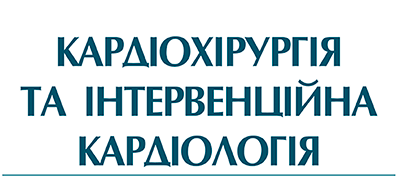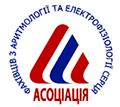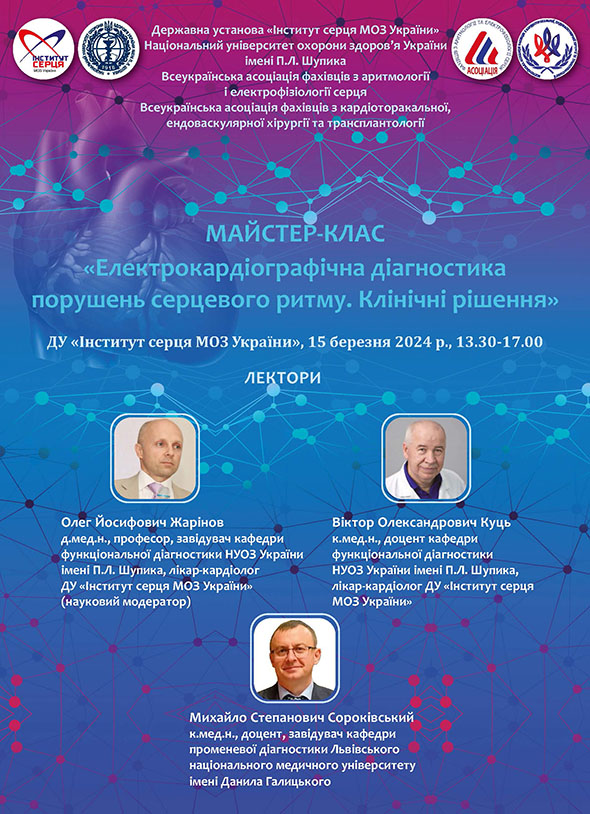Сучасні методи діагностики та прогнозування результатів хірургічної корекції аортального стенозу
Б.М. Тодуров, Н.В. Понич, О.А. Єпанчінцева, О.Й. Жарінов
Література
1. Baumgartner H, Hung J, Bermejo J. EAE/ASE recommendations on echocardiographic assessment of valve stenosis: EAE/ASE recommendations for clinical practice. Eur J Echocardiography. 2009;10:1-25.
2. Blais C, Burwash IG, Mundigler G. et al. Projected valve area at normal flow rate improves the assessment of stenosis severity in patients with low-flow, low-gradient aortic stenosis. The Multicenter TOPAS (Truly or Pseudo-Severe Aortic Stenosis) Study. Circulation. 2006;113:711-721.
3. Brown J, Jenkins C, Marwick TH. Use of myocardial strain to assess global left ventricular function: a comparison with cardiac magnetic resonance and 3-dimensional echocardiography. Am Heart J. 2009;157:102-105.
4. Brown ML, Pellikka PA, Schaff HV. et al. The benefits of early valve replacement in asymptomatic patients with severe aortic stenosis. J Thorac Cardiovasc Surg. 2008;135:308-315.
5. Bruch C, Stypmann J, Gradaus R. et al. Tissue Doppler imaging in patients with moderate to severe aortic valve stenosis: Clinical usefulness and diagnostic accuracy. Am Heart J. 2004;148:696-702.
6. Carabello BA, Paulus WJ. Aortic stenosis. Lancet. 2009;373:956-966.
7. Carroll JD, Carroll EP, Feldman T. et al. Sex-associated differences in left ventricular function in aorticstenosis of the elderly. Circulation.1992;86:1099-1107.
8. Chambers JB. Aortic stenosis. Eur J Echocardiography. 2009;10:111-119.
9. Clavel MA, Burwash IG, Mundigler G, Dumesnil JG. Validation of conventional and simplified methods to calculate projected valve area at normal flow rate in patients with low flow, low gradient aortic stenosis: the multicenter TOPAS (True or Pseudo Severe Aortic Stenosis) study. J Am Soc Echocardiogr. 2010;23 (4):380-386.
10. Collinson J, Henein M, Flather M. et al. Valve replacement for aortic stenosis in patients with poor left ventricular function: comparison of early changes with stented and steintless valve. Circulation. 1999;100 (Suppl II):111-115.
11. Connolly HM, Oh JK, Schaff HV. et al. Severe aortic stenosis with low transvalvular gradient and severe left ventricular dysfunction: result of aortic valve replacement in 52 patients. Circulation. 2000;101:1940-1946.
12. Dandel M, Dworatzek E, Regression of myocardial hypertrophy after aortic valve replacement: faster in women? Circulation. 2010;122:S23-S28.
13. DeFilippi CR, Willett DL, Brickner ME. et al. Usefulness of dobutamine echocardiography in distinguishing severe from nonsevere valvular aortic stenosis in patients with depressed left ventricular function and low transvalvular gradient. Am J Cardiol. 1995;75:191-194.
14. Delgado V, Tops LF, van Bommel RJ. et al. Strain analysis in patients with severe aortic stenosis and preserved left ventricular ejection fraction undergoing surgical valve replacement. Eur Heart J. 2009;30:3037-3047.
15. Douglas PS, Otto CM, Mickel MC. et al. Gender differences in left ventricle geometry and function in patients undergoing balloon dilatation of the aortic valve for isolated aortic stenosis: NHLBI Balloon Valvuloplasty Registry. Br Heart J. 1995;73:548-554.
16. Drazner MH, Rame JE, Marino EK. et al. Increased left ventricular mass is a risk factor for the development of a depressed left ventricular ejection fraction within five years: the Cardiovascular Health Study. J Am Coll Cardiol. 2004;43:2207-2215.
17. Duarte IG, Murphy CO, Kosinski AS. et al. Late survival after valve operation in patients with left ventricular dysfunction. Ann Thor Surg. 1997;64:4:1089-1095.
18. Eichinger WB, Botzenhardt F, Gunzinger R. et al. Left ventricular mass regression after aortic valve replacement with the mosaic bioprosthesis. J. Heart Valve Dis. 2002;11:529-536.
19. Faggiano P, Antonini-Canterin F, Ribichini F. et al. Pulmonary artery hypertension in adult patients with symptomatic valvular aortic stenosis. Am J Cardiol. 2000;85:204-208.
20. Fliegner D, Schubert C, Penkalla A. et al. Female sex and estrogen receptor attenuate cardiac remodeling and apoptosis in pressure overload. Am J Physiol Regul Integr Comp Physiol. 2010;298:R1597-R1606.
21. Flores-Marín A, Gómez-Doblas J. et al. Long-Term Predictors of Mortality and Functional Recovery After Aortic Valve Replacement for Severe Aortic Stenosis With Left Ventricular Dysfunction. Rev Esp Cardiol. 2010;63 (1):36-45.
22. Franke A, Kühl HP. Diagnosis and assessment of severity of aortic valve stenosis. Herz. 2006;31:856.
23. Gaudino M, Alessandrini F. et al. Survival after aortic valve replacement for aortic stenosis: does left ventricular mass regression have a clinical correlate?. Eur. Heart J. 2005;26:51-57.
24. Gjertsson P. et al. Left ventricular diastolic dysfunction late after aortic valve replacement in patients with aortic stenosis. Amer J Cardiology. 2005;96:722-727.
25. Goland S, Trento A, Iida K. et al. Assessment of aortic stenosis by three-dimensional echocardiography: an accurate and novel approach. Heart. 2007. 93:801-807.
26. Iung B, Baron G, Butchart E.G. et al. A prospective survey of patients with valvular heart disease in Europe: The Euro Heart Survey on Valvular Heart Disease. Eur Heart J. 2003;24(13):1231-1243.
27. Jacobs LD, Salgo IS, Goonewardena S. et al. Rapid online quantification of left ventricular volume from real-time three-dimensional echocardiographic data. Eur Heart J. 2006;27:460-468.
28. Jander N, Minners J, Holme I. et al. Outcome of patients with low-gradient ‘severe’ aortic stenosis and preserved ejection fraction. Circulation. 2011;123:887-895.
29. Kang DH, Park SJ, Rim JH. et al. Early surgery versus conventional treatment in asymptomatic very severe aortic stenosis. Circulation. 2010;121. 1502-1509.
30. Katholi R, Daniel M. et al. Left Ventricular Hypertrophy: Major Risk Factor in Patients with Hypertension: Update and Practical Clinical Applications. Intern J Hypertension. 2011;1:10.
31. Kapoor N, Varadarajan P, Pai RG. Echocardiographic predictors of pulmonary hypertension in patients with severe aortic stenosis. Eur J Echocardiography. 2008;9:31-33.
32. Kuhl HP, Schreckenberg M, Rulands D. et al. High-resolution transthoracic real-time three-dimensional echocardiography. J Am Coll Cardiol. 2004;43:2083-2090.
33. Lang RM, Mor-Avi V, Sugeng L. et al. Threedimensional echocardiography: the benefits of the additional dimension. J Am Coll Cardiol. 2006;48:2053-2069.
34. Lester SJ, Heilbron B, Gin K. et al. The natural history and rate of progression of aortic stenosis. Chest. 1998;113:1109-1114.
35. Levy F, Laurent M, Monin JL. et al. Aortic valve replacement for low-flow/low-gradient aortic stenosis operative risk stratification and long-term outcome: a European multicenter study. J Am Coll Cardiol. 2008;51:1466-1472.
36. Lung B, Baron G, Tornos P. et al. Valvular heart disease in the community: a European experience. Curr Probl Cardiol. 2007;32:609-661.
37. Lund O, Flo S, Jensen FT. et al. Left ventricular systolic and diastolic function in aortic stenosis. Prognostic value after valve replacement and underlying mechanisms. Eur Heart J. 1997;18 (12):1977-1987.
38. Mancini GB, Dahlof B, Díez J. Surrogate markers for cardiovascular disease: structural markers. Circulation. 2004;109:IV22-IV30.
39. Manovel A, Dawson D, Smith B, Nihoyannopoulos P. Assessment of left ventricular function by different speckle-tracking software. Eur J Echocardiogr. 2010;11:417-421.
40. Marwick TH, Leano RL, Brown J. et al. Myocardial strain measurement with 2-dimensional speckle-tracking echocardiography: definition of normal range. JACC Cardiovasc Imaging. 2009;2:80-84.
41. McCarthy PM. Aortic valve surgery in patients with left ventricular dysfunction. Semin Thorac Cardiovasc Surg. 2002;14:137-143.
42. Minners J, Allgeier M, Gohlke-Baerwolf C. et al. Inconsistencies of echocardiographic criteria for grading of aortic valve stenosis. Eur Heart J. 2008;29:1043-1048.
43. Monin JL, Quere JP, Monchi M. et al. Low-gradient aortic stenosis: operative risk stratification and predictors for long-term outcome: a multicenter study using dobutamine stress hemodynamics. Circulation. 2003;108:319-324.
44. Morena G, Saura D, Oliva MJ. et al. Real-time three-dimensional transesophageal echocardiography in the assessment of aortic valve stenosis. Eur. J. Echocardiogr. 2010;11:9-13.
45. Mor-Avi V, Lang M. Current and Evolving Echocardiographic Techniques for the Quantitative Evaluation of Cardiac Mechanics: ASE/EAE Consensus Statement on Methodology and Indications Endorsed by the Japanese Society of Echocardiography. J Am Soc Echocardiogr. 2011;24:277-313.
46. Mor-Avi V, Sugeng L, Lang RM. Real-time 3-dimensional echocardiography: an integral component of the routine echocardiographic examination in adult patients? Circulation. 2009;119:314-329.
47. Nakai H, Takeuchi M, Yoshitani H. et al. Pitfalls of anatomical aortic valve area measurements using two-dimensional transoesophageal echocardiography and the potential of three-dimensional transoesophageal echocardiography. Eur J Echocardiography. 2010;11:369-376.
48. Nagueh S, Appleto C. et al. Recommendations for the evaluation of left ventricular diastolic function by echocardiography. Eur J Echocardiogr. 2009;10:165-193.
49. Nishimura RA, Grantham JA, Connolly HM. et al. Low-output, low-gradient aortic stenosis in patients with depressed left ventricular systolic function: the clinical utility of the dobutamine challenge in the catheterization laboratory. Circulation. 2002;106:809-813.
50. Nishimura RA. et al. AHA/ACC Guideline for the Management of Patients With Valvular Heart Disease. Circulation. 2014;129:27-46.
51. Nkomo VT, Gardin JM, Skelton TN. et al. Burden of valvular heart diseases: a population-based study. Lancet. 2006;368:1005-1011.
52. Novaro CM, Katz R, Gottdiener JS. et al. Clinical factors but not C reactive protein predict progression of calcific aortic valve disease: The Cardiovascular Health Study. J Am Coll Cardiol. 2007;50:1992-1998.
53. Osnabrugge RL, Mylotte D, Head SJ. et al. Aortic stenosis in the elderly: disease prevalence and number of candidates for transcatheter aortic valve replacement: a meta-ana lysis and modeling study. J Am Coll Cardiol. 2013;62:1002-1012.
54. Pai R, Varadarajan P, Kapoor N, Bansal R. Aortic Valve Replacement Improves Survival in Severe Aortic Stenosis Associated With Severe Pulmonary Hypertension. Ann Thorac Surg. 2007;84:80-86.
55. Pereira JJ, Lauer MS, Bashir M. et al. Survival after aortic valve replacement for severe aortic stenosis with low transvalvular gradients and severe left ventricular dysfunction. J Am Coll Cardiol. 2002;39:1356-1363.
56. Płońska-Gościniak E, Lipiec P, Lancellotti P. Prognostic value of low-dose dobutamine stress echocardiography in patients with aortic stenosis and impaired left ventricular function. Arch Med Sci. 2013;9:434-439.
57. Quere JP, Monin JL, Levy F. et al. Influence of preoperative left ventricular contractile reserve on postoperative ejection fraction in low-gradient aortic stenosis. Circulation. 2006;113:1738-1744.
58. Roberts WC, Ko JM. Frequency by decades of unicuspid, bicuspid and tricuspid aortic valves i adults having isolated aortic valve replacement for aortic stenosis with or without associated aortic regurgitation. Circulation. 2005;111:920-925.
59. Schattke S, Baldenhofer G. Acute regional improvement of myocardial function after interventional transfemoral aortic valve replacement in aortic stenosis: A speckle tracking echocardiography study. Cardiovasc Ultrasound. 2012;10:15.
60. Stewart BF, Siscovick D, Lind BK. et al. Clinical factors associated with calcific aortic valve disease: Cardiovascular Health Study. J Am Coll Cardiol. 1997;29:6304.
61. Sugeng L, Shernan SK, Salgo IS. et al. Live 3-dimensional transesophageal echocardiography initial experience using the fully-sampled matrix array probe. J Am Coll Cardiol. 2008;52:446-449.
62. Sutton MSJ, Plappert T, Speigel A. et al. Early postoperative changes in left ventricular chamber size, architecture, and function in aortic stenosis and aortic regurgitation and their relation to intraoperative changes in afterload: a prospective two-dimensional echocardiographic study. Circulation. 1987;76:77-89.
63. Takeda S, Rimington H, Smeeton N, Chambers J. Long axis excursion in aortic stenosis. Heart. 2001;86:52-56.
64. Tribouilloy C, Le´vy F, Rusinaru D, Gue´ret P. et al. Outcome after aortic valve replacement for low-flow/low-gradient aortic stenosis without contractile reserve on dobutamine stress echocardiography. J Am Coll Cardiol. 2009;53:1865-1873.
65. Vahanian A, Alfieri O. et al. Guidelines on the management of valvular heart disease (version 2012) The Joint Task Force on the Management of Valvular Heart Disease of the European Society of Cardiology (ESC) and the European Association for Cardio-Thoracic Surgery (EACTS). Eur J Cardio-Thoracic Surgery. 2012;42:S12-S18.
66. Villari B, Campbell SE, Schneider J. et al. Sex-dependent differences in left ventricular function and structure in chronic pressure overload. Eur Heart J. 1995;16:1410-1419.
67. Witt H, Schubert C, Jaekel J. et al. Sexspecific pathways in early cardiac response to pressure overload in mice. J Mol Med. 2008;86:1013-1024.
| [PDF] | [Зміст журналу] |












